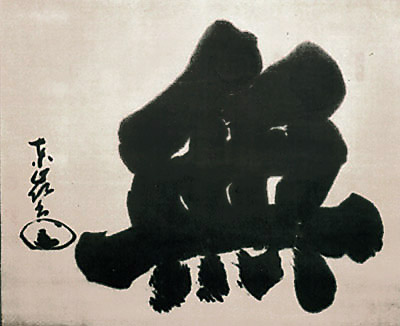Masterly show of Zen-inspired art
| It's the best survey of its type in a decade By Kenneth Baker In the 18th century, enlightenment had almost opposite meanings in East and West. To Europeans it meant release by reason from superstition, that is, from religion and the burden of the past. In Japan, at least to adherents of Zen Buddhism, enlightenment promised release from the shackles of reason into life's immediacy. "Zen Painting and Calligraphy" at the Asian Art Museum surveys artifacts made to evoke and spur that sense of liberation. Yoko Woodson, the Asian's curator of Japanese art, has assembled for this one-venue show many of the most famous examples of Zen-inspired art in American collections. The 60-odd works on view are exemplary in iconography, quality, historic importance and impact. Consider a small hanging scroll of the Japanese character "Mu," for "nothing" or "no," by Torei Enji (1721-1792).
|
 "Banana Plant (Basho)" by Sengai Gibon (1750-1837) |
 The Japanese character "Mu," for "nothing" or "no," by Tori Enji (1721-1792) |
Briskly done with a large, very full brush, the ideogram has an almost palpable force -- like the "Blam" that Roy Lichtenstein lifted from comic strips -- even to a viewer who cannot read it. One who can may recognize it as the answer to a famous Zen koan -- or teaching paradox -- given by a Chinese Zen master.
|
Asked whether a dog partakes of the Buddha nature, the sage shouted "Mu!": less a "no" than a slap at the questioner's sophistry.
The Rinzai sect, the Zen mainstream during the period surveyed here, held that enlightenment might come suddenly, under almost any circumstances, to the mind prepared by meditation. This idea gave Zen more popular appeal than strains of Buddhism that insist on monastic discipline and long study of Buddhist scripture.
The works of Rinzai school monks, most unschooled as artists, predominate in "Zen: Painting and Calligraphy," the finest survey of its kind in a decade.
Hakuin Ekaku (1685-1768), famous as a Rinzai school adept and a prolific painter and calligrapher, is richly represented here.
The flair and humor of Zen painting set it apart from the main traditions of art and connoisseurship in Japan. Those qualities shine from Hakuin's many imaginary portraits of the Zen patriarch Daruma.
Daruma is the Japanese name for Bodhidharma, who supposedly transmitted Zen practice from India to China in the sixth century.
The show includes 11 portraits of Daruma by five artists of different generations, enough variety that we can learn to recognize Daruma's typical qualities as art conventions.
He tends to be bald and bearded, with a large nose, bulging eyes and a grave expression. Most portraits show him sitting, a mountainous presence, his figure defined by one or two long, fluent brush strokes.
A second selection of Daruma images represents another aspect of Zen lore, the legend that Daruma attained enlightenment by meditating for nine years facing a blank wall.
A "wall-facing Daruma" may be a simple outline, barely suggestive of a seated figure, as in Jiun Onko's version, where the emptiness of the page stands for the blankness of the wall and the meditator's emptiness of ego.
The show's hanging hints at a link between the looplike figure of the "wall- facing Daruma" and examples of "Enso." Execution of an "Enso," an enigmatic one-stroke ink circle, may be the purest display of the aptitude for quick, appropriate action that marks the awakened mind.
The simmer of caricature in portrayals of Daruma boils over in images of Hotei, another stock figure of Zen painting, a corpulent hermit-teacher who totes a treasure bag symbolic of ordinary life's richness in the enlightened view. Brisk, almost artless execution, like that of "Banana Plant (Basho)" by Sengai Gibon (1750-1837), is the earmark of most Zenga, as Zen-inspired paintings are called.
But "Zen: Painting and Calligraphy" also includes works of supreme refinement, such as "Hotei Pointing at the Moon" by Fugai Ekun (1568-1864).
Here the whimsical Hotei points straight up. The moon, not depicted, floats in the viewer's imagination. Hotei and the artist point to the fact that the moon exists outside the mind.
| MUSEUM SHOW |
| ZEN PAINTING AND CALLIGRAPHY, 17TH-20TH CENTURIES: Paintings, calligraphy and ritual implements. Through Oct. 7. Asian Art Museum of San Francisco, Golden Gate Park, San Francisco. (415) 379-8800 or www.asianart.org. |